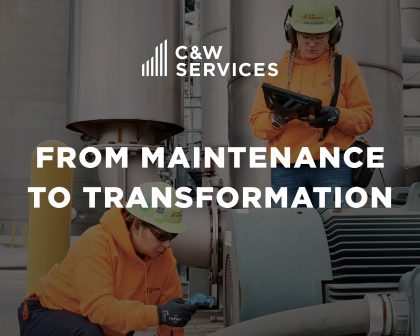By Claudia Salgado-McDonald, senior director of productivity and utilization
As members of the facilities management industry, we are accustomed to working hard every day to provide the highest level of service to our clients. However, in that pursuit, we’re not always the most careful about the state of our work areas. We tell ourselves that we—ll clean it up later, that it doesn’t matter right now. But the truth is that our work areas demand the same level of discipline that we apply to other aspects of our job because a clean work area not only boosts productivity, it also results in a happier, safer working environment. This approach can be successful whether the term “work area” refers to a facility manager’s desk, a janitor’s cleaning cart, a mobile engineer’s truck, a mailroom coordinator’s reception area, or any other type of work environment. It can even be expanded to entire supply closets, loading docks, and beyond. So, no matter what area of facilities management you work in, making sure that your work area is in good condition is a top priority. It is one thing to talk about safety, but when it comes to providing a high level of service to our clients, we must also walk the walk.
One of the most widely used methodology to keep work areas in good shape is the 5S. Deriving its name from the Japanese words seiri, seiton, seiso, seiketsu, and seiketsu, the methodology details how to organize a work area for efficiency and effectiveness by identifying and storing items used, maintaining the area and items, and sustaining the methodology over time.
- Clean up your work area and determine which items are needed to complete your job.
- Establish an area—commonly referred to as a red tag—to place unnecessary items and materials that cannot be immediately disposed of. Dispose of those unnecessary items when possible.
- Have a supervisor check the area on a regular basis.
- Analyze your workflow and arrange items according to their use. The most frequently used items should be the nearest to the work space.
- Make sure that all necessary items are in their proper place, in close proximity to one another, and can be easily accessed.
- Label all lockers, drawers, and cupboards so people can know what is kept inside.
- Adopt cleaning as a daily activity and as a part of regular inspection.
- Clean the work space before starting a job and after the job is complete.
- Keep a log of all the places that need to be improved. Develop a plan and distribute responsibility for checking the status of tools and materials.
- Create visual controls and guidelines that keep the work space organized, orderly, and clean.
- All 5S documents and checklists should be publicly displayed.
- Establish a standard practice for regularly repeating the first three S—s.
- Train everyone in the 5S methodology and implement it across your work area.
- Establish periodic checks to make sure that the first four S’s are being implemented properly.
- Follow the 5S methodology, but also be open to suggestions and improvements.
The 5S Methodology is cyclical, meaning that it is always ongoing and needs to be adhered to constantly. This continued effort is worth the time and effort, though, as a strong commitment to 5S means improved safety, productivity, a reduction in waste, and the creation of a solid foundation on which continual improvement is possible. We’ve seen successful applications of 5S across numerous client sectors like government, retail, healthcare, higher education, life sciences, public venues, and commercial.
Contact us to engage with experts who oversee our platform excellence.





